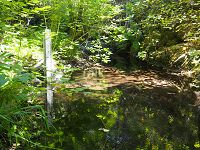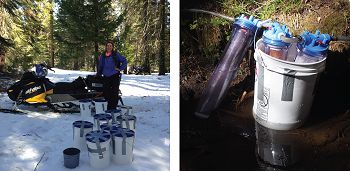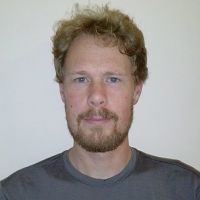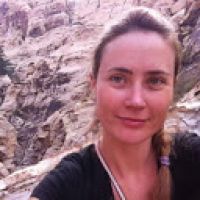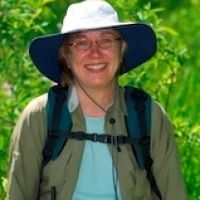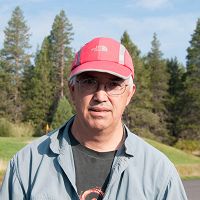Pushing the Limits on Water Isotope Measurement: Lawrence Livermore and UC Merced
Where, oh where, can a single drop of water travel in the critical zone? From snowpack to soil; then to stream or to tree? Isotopes can whisper the secret life of a water droplet, as University of California Merced graduate student Melissa Thaw likes to say. How old is it? Where has it traveled from? How long was its layover in an alpine meadow? And researchers from Lawrence Livermore National Laboratory and University of California Merced are trying to answer these questions and others specifically targeted at understanding the timing and routing of water as it travels through the critical zone by measuring isotopes found in the waters of streams, snowpack, soil, precipitation, and vegetation.
Many different isotopes are found in natural water sources, but only a few radioactive isotopes are effective for this sort to water tracking. These few isotopes of interest can exist in very, very, very small concentrations-- just a few useful atoms in every trillion molecules of water. State-of-the-art laboratory machinery with ultra-high sensitivity is required to detect these ultra-low concentrations. Enter Lawrence Livermore National Laboratory. Ate Visser, Amanda Deinhart, and Brad Esser are hydrologists and radiochemists at Lawrence Livermore National Laboratory who have access to machinery that can detect isotopes like these at some of the lowest levels in the world. They have teamed up with hydrologists Martha Conklin and Melissa Thaw at the University of California Merced to collect and analyze water samples from the Southern Sierra Critical Zone Observatory.
With differing half-lives, these isotopes can reveal the time that has passed in a water droplet's travels for up to 60 years. Tritium (hydrogen-3) can be used to detect relatively older water, from about 10 to 60 years old since it precipitated out of the sky, while sulfur-35 can be used to detect younger water less than two years old. And to trace the middle-aged water, they recently added one more radioactive isotope to their water fingerprinting toolbox: sodium-22. "We're adding sodium-22 as a hydrologic tracer because its decay rate is between tritium and sulfur-35," says Deinhart. "It gives us a higher-resolution picture of water ages that are older than two years and younger than ten years."
With these three isotopes in conjunction, researchers can learn if the water in a tree at this moment came from last spring's snowmelt or this fall's rain storms-- or some combination of the two. And they can evaluate how long it takes water to move from one part of a watershed to another. "We can understand how much precipitation is entering a stream, how old the water is, and how much of it is that old," says Thaw. And with Thaw's high-frequency collection of field samples, sometimes multiple times a week, the team can measure both rapid and long-term changes in this montane water cycle.
Old (left) and new (right) methods of isotope hydrology field sampling.
Left: Melissa Thaw prepares to load buckets of sample water on a snowmobile. The water will be taken to Lawrence Livermore National Laboratory for sulfur-35 analysis.
Right: The new method of surface water sampling. Ion-exchange resin columns are used with a water pump in the P301 stream to concentrate sulfur-35 and sodium-22.
Photos by Michelle Gilmore.
Detecting these low-concentration isotopes can require high volumes of water though. In the case of sulfur-35 measurement, 20 liters of water are needed to reach a concentration of the isotope that's within even Lawrence Livermore's detection limits. Last winter, Thaw and others frequently snowmobiled several hundred liters of water out of the field every month, loaded in the back of a pickup truck in five- and ten-gallon buckets. This fall though, Deinhart, Thaw, and their colleagues developed a new sampling method to reach the needed concentrations of sodium and sulfur while still in the field. Using linked ion-exchange resin columns, the resin columns capture and concentrate the isotopes of interest as water is pumped through them on-site. Sample water is pumped back to its source immediately after being filtered through the columns, and scientists only need to bring a few resin columns back to the lab. "This new method not only streamlines the chemistry we have to do in the lab," says Thaw, "but also eliminates the step of needing to take hundreds of liters of water out of the field."
This novel approach to in-situ water chemistry sample collection has the potential to change methods for collecting water samples on a global scale. "We hope that this project that we're working on at the Southern Sierra Critical Zone Observatory could lead to a more streamlined method of collecting sulfur-35 samples anywhere," says Deinhart.
The data collected in this study are also being used to parameterize a computer model that researchers at Colorado School of Mines and Lawrence Livermore are using to predict the pathways of water through the critical zone. Read about both of these and other topics researchers are exploring on our Research Foci page.
Written by Michelle Gilmore
Old (left) and new (right) methods of isotope hydrology field sampling.
Left: Melissa Thaw prepares to load buckets of sample water on a snowmobile. The water will be taken to Lawrence Livermore National Laboratory for sulfur-35 analysis.
Right: The new method of surface water sampling. Ion-exchange resin columns are used with a water pump in the P301 stream to concentrate sulfur-35 and sodium-22.
Photos by Michelle Gilmore.
News Category:
RESEARCH |
INFRASTRUCTURE |
DATA |
MODELS |
PEOPLE |
AWARD |
EDUCATION/OUTREACH
People Involved
CZO
-
Sierra, COLLABORATOR
-
Sierra, GRAD STUDENT
-
Sierra, INVESTIGATOR
-
Sierra, COLLABORATOR
Publications
2016
Tracking water through the Southern Sierra Critical Zone Observatory using radioactive and stable isotopes . Thaw, M.; Visser, A.; Deinhart, A.L.; Sharp, M.; Everhart, A.; Bibby, R.K.; Conklin, M.H. (2016): Fall Meeting, American Geophysical Union, December 2016. Abstract H31K-07.
2015
Variability of Residence Time tracer Concentrations at the Southern Sierra Critical Zone Observatory during the California Drought. Visser, A., Thaw, M., Stacy, E., Hunsaker, C., Bibby, R., Deinhart, A.L., Schorzman, K., Egnatuk, C., Conklin, M., Esser, B. (2015): H21F Hydrochronology: Advances in Tracer Methods, Modeling Techniques, and Applications of Residence Times in Hydrology Research I Posters., presented at 2015 Fall Meeting, AGU, San Francisco, CA, 14-18 Dec.
Explore Further
